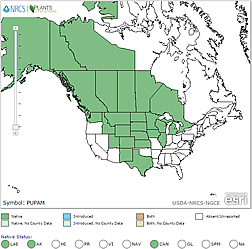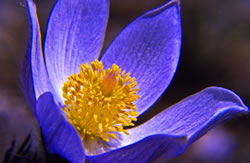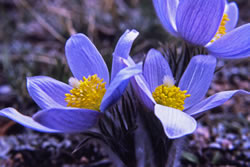Plant of the Week
 Range map of Pulsatilla patens var. multifida. USDA PLANTS Database.
Range map of Pulsatilla patens var. multifida. USDA PLANTS Database.
 Pulsatilla patens var. multifida, pasqueflower. Photo by Charmaine Delmatier.
Pulsatilla patens var. multifida, pasqueflower. Photo by Charmaine Delmatier.
 Pulsatilla patens var. multifida, pasqueflower. Photo by Charmaine Delmatier.
Pulsatilla patens var. multifida, pasqueflower. Photo by Charmaine Delmatier.
 Pulsatilla patens var. multifida, pasqueflower. Photo by Charmaine Delmatier.
Pulsatilla patens var. multifida, pasqueflower. Photo by Charmaine Delmatier.
Pasqueflower (Pulsatilla patens var. multifida, also known as Anemone patens var. multifida)
By Charmaine Delmatier (2016)
Ranunculaceae, commonly known as the buttercup or crowfoot family, has a global distribution with about 60 genera and 1,700 species. They are more abundant in temperate and cooler regions on both the northern and southern hemispheres, and many are located in wetter areas. The Latin derivative for Ranunculaceae is rānunculus for "little frog", and more specifically from rāna for "frog." In North America, there are approximately 22 genera and 284 species. Most know this family for its beautiful brightly colored yellow buttercups (Ranunculus) and for vibrant purple larkspurs (Delphinium). Not only do they occur in the wild, but many are found in private gardens.
However, another genus which is highly competitive for best of show are the robust bell-shaped flowers of Pulsatilla. There are approximately 150 species worldwide, with 25 occurring in North America. Most are usually restricted to cooler temperate climates and often reach into arctic or alpine regions; and this is where we find pasqueflower (Pulsatilla patens var. multifida). Pulsatilla patens var. multifida is often placed in the genus Anemone, as Anemone patens var. multifida. Other common names include Eastern pasqueflower, prairie crocus, and cutleaf anemone.
According to the latest treatment by Dutton, Keener, and Ford in Flora of North America, pasqueflower is distributed worldwide from Canada to Eurasia to North America. Its elevational range is unusually broad from 330 to 12,500 feet. It is an early bloomer, starting in April and continuing through August, depending on the elevation and cooler latitudes. It can be found on prairies, open slopes and woods, or granite outcrops.
A strong overwintering perennial, in the spring, it can grow up to 17 inches tall with only one to few magnificent bell-shaped flowers. The flower consists of six to eight individual deep- blue to purple petal-like sepals which are united at the base; contrast this with a whorl of dark- brown to dark-purple linear leaves loosely encompassing the deep-blue flower. Within the center of the flower are 150 to 200 tightly arranged yellow stamens and in the center of this yellow profusion of pollen is a singular bundle of many pistils with their long styles starting to extend upwards. Each style is covered with a multitude of soft plumose hairs. The 2 to 4 centimeters petal-like sepals are placed on top of a single hairy peduncle; and with age, the peduncle will keep extending beyond the whorl of leaves until the sepals dry and fall off. With more age, as the peduncle gets taller and taller, the styles get longer and longer until the final entire seed head looks much like a shaggy ball of hairy threads. Covering the entire plant, from the sepals along the stem to the dissected leaves, are very long silky hairs, which gives the entire plant a white soft-silky look that is attractively accentuated when the sun shines through. Hence the other common name; prairie smoke. Early on, the deep-blue sepals slightly extend past the whorl of dark dissected leaves creating the well-known deep-blue bell flowers, and it is this attractive feature that dots the countryside on an early spring day after a long winter of snow.
Based on research by Turner and Szczawindski, many species of Pulsatilla contain an unpleasant and bitter oil called protoanemonin, which can cause severe reactions both topically and gastrointestinally. It has been estimated that 30 ingested fresh plants can be lethal. On a brighter note, this irritating oil is short-lived once the plant is dried and the protoanemonin breaks down quickly into a harmless compound. Caution is used never to ingest the fresh plant, but most all portions of the dried plant have some sort of medicinal agent.
Pasqueflower (Pulsatilla patens var. multifida) is a powerful healing agent. Native Americans and settlers used small amounts for various ailments and conditions: dried leaves (most likely a tea) for rheumatism, a poultice of pressed dried leaves as a topical treatment, an aroma-therapy bouquet of freshly dried ground leaves to alleviate headaches, and pulverized roots were used to combat lung disorders.
Pasqueflower (Pulsatilla patens) is the provincial flower of Manitoba, Canada. A very close relative, American pasqueflower (Pulsatilla hirsutissima), also known as the May Day flower, is the South Dakota state flower. It is more purple in hue than our striking blue pasqueflower. Pasqueflower’s beauty and popularity is not restricted to North America; (using the synonymous genus Pulsatilla) several of its varieties are recognized worldwide and are the official county flowers for Hertfordshire and Cambridgeshire, England, and Oppland, Norway.


